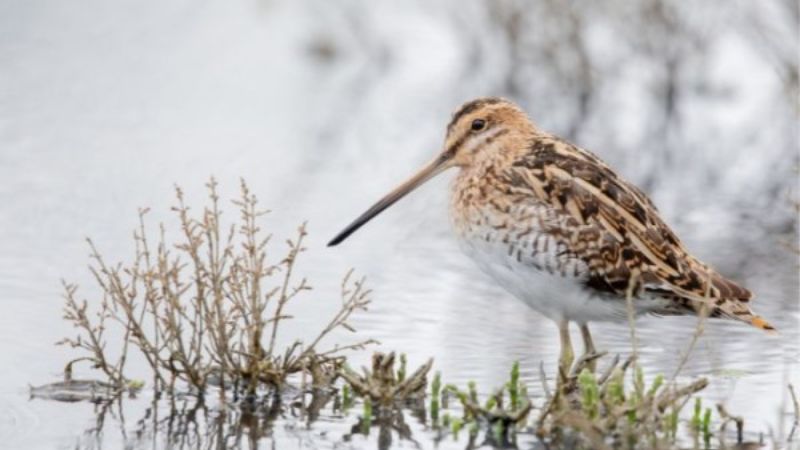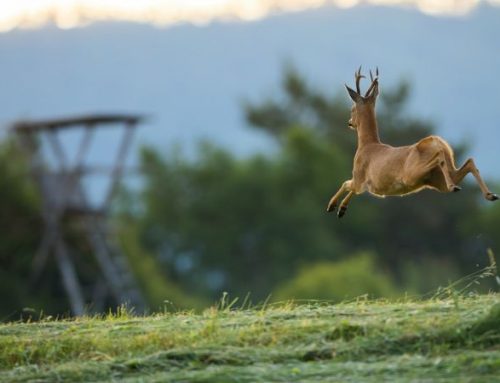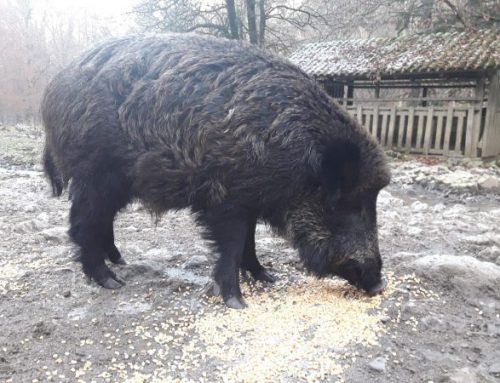Snipe hunting is becoming increasingly challenging, and when it happens, it’s a triumph of emotions.
Amidst mud and marshes, under a leaden sky reflecting in the puddles of an immense frozen field, is where the hunter’s heart fills with joy.
As the dog points steadily, adrenaline rises and the unmistakable sound of “gneck” echoes in the ears. Amidst the low vegetation, a nearly imperceptible movement, the sight of the snipe remains just an idea until it stands out against the sky, and in its presence, everything becomes relative!
The muffled shot, softened by the nature of the terrain, and a tuft of feathers with unique colors awaken the hunter from the dream, and everything becomes reality: this is snipe hunting!
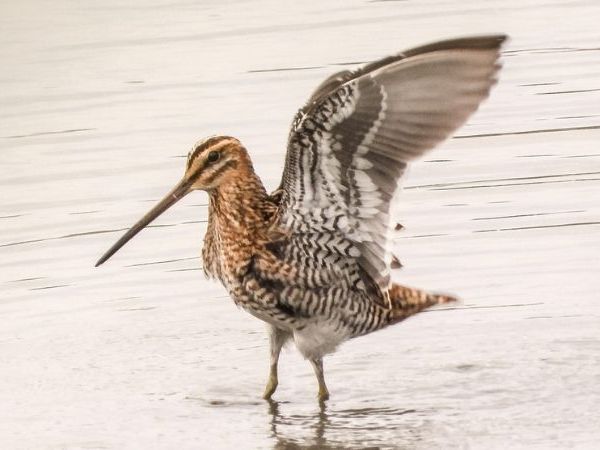
Belonging to the Scolopacidae family, the “Gallinago Gallinago,” more commonly known as the snipe, is a migratory species widespread in Europe.
The camouflaged plumage is similar in both sexes, with brown coloring interrupted by black streaks and bands that extend from the eyes towards the back of the head. The belly is lighter than the back. It has a long black beak, perfectly adapted for life in wetlands and foraging near watercourses.
Snipe hunting is a much-loved activity due to the cunning and intelligence of this bird, making it a five-star migratory species. This is evidenced by the numerous names it has been given, such as winged arrow, hunter’s school, and knights’ dish.
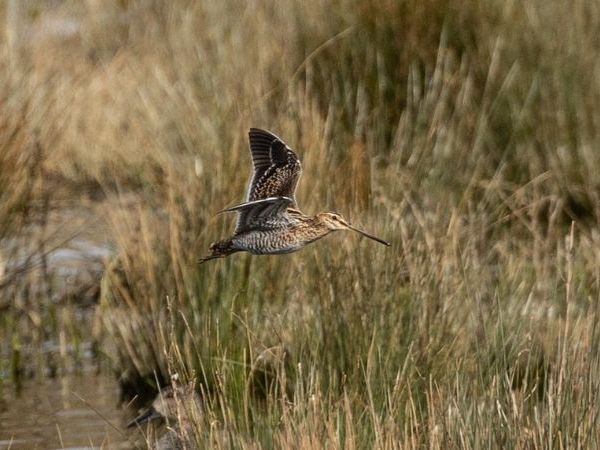
The hunter must be vigilant and proceed silently, remembering that once the snipe is alarmed, it does not stalk or attempt to hide in the vegetation but takes off. When it takes flight, almost always against the wind, it is easily identifiable by its call and flight pattern, which is fast, low, and zigzagging before rising to considerable height.
This species is widely distributed as a breeder across the globe, from central and northern Europe and Asia to North America, presenting itself as a medium to long-range migrant.
The Art of Snipe Hunting: With or Without the Dog
Hunting the snipe is not merely a test of skill—it is a subtle dance between instinct, precision, and patience. This elusive wader, with its zigzag flight and marshland habitat, has long enchanted hunters across Europe. Whether pursued with the help of a well-trained dog or through the quiet perseverance of the solitary hunter, snipe hunting is among the most refined expressions of the venatic art.
Hunting with the Dog: A Choreography of Trust
To hunt the snipe with a pointing dog is to engage in a dialogue of mutual understanding. The dog’s nose, trained to perfection, becomes the hunter’s most valuable instrument. In low reeds or flooded meadows, the snipe lies motionless, relying on camouflage more than escape—until that very moment when the dog freezes on point. Time seems to suspend. The hunter approaches slowly, eyes scanning the terrain. Then, like a crack of thunder across the wet silence, the snipe bursts into flight—erratic, explosive, challenging.
The shot must be instinctive. There is no time to aim. Only those who have honed their reflexes through countless outings will find success. And even then, the snipe will often win the duel.
For those who live for the silent thrill of the point, the loyalty in a dog’s eyes, and the sudden rise of the bird in the mist, hunting snipe with a dog is an emotional experience—one etched in morning dew and the scent of peat and river water.
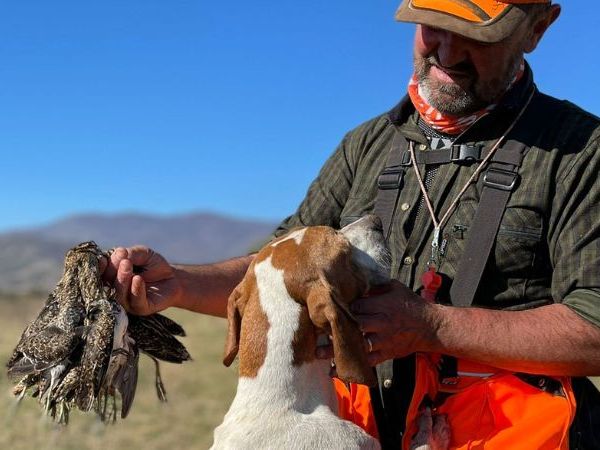
Hunting Without the Dog: The Ancient Way
Hunting snipe without a dog demands a different type of discipline—one born of solitude, observation, and the ability to read a landscape intimately. The solitary hunter becomes a slow-moving silhouette against the horizon, stalking through wetlands with deliberate care, eyes trained on every flicker of movement.
The snipe often rises only when almost stepped upon. The hunter, unassisted by canine senses, must learn to anticipate the terrain: depressions near water, patches of cover too thick to walk through, the silent flutter that precedes the telltale shriek and twist of wings.
Here, the pursuit is more meditative. It is a slow communion with the environment, a return to older ways, where silence and sensitivity replace partnership. Success, when it comes, feels like a gift rather than a conquest.
Snipes in Scotland: the Isle of Bute
Montefeltro opens the doors to a destination already well-known to avid bird hunters: the Isle of Bute in Scotland. Here, the snipe is very common, finding an excellent habitat on this Scottish island thanks to the abundant presence of marshes and wetlands.

The accessible wetlands for hunting activities make the Isle of Bute in Scotland an excellent hunting destination, not only for the already well-known woodcocks but also for the snipe, offering a uniquely flavored hunting experience.
Needless to say, the territory of the Isle of Bute is authentic, free from intensive farming and herbicides. Every corner of the land is genuine, making the island the perfect setting for snipe hunting—a true hunting paradise!
Movement and Strategy
Snipe hunting rewards those who move slowly, scan constantly, and stay alert even when the morning feels quiet. If using a dog, let it lead without pressure—trust in its pace and its pauses. If hunting alone, take your time and let your eyes lead your steps.
Above all, remain patient. Many a hunter has walked for hours before encountering the single flight that made the whole day unforgettable.
The hunting dogs
The best hunting dogs for snipe hunting are those with excellent nose sensitivity, stamina, and a natural instinct for pointing and retrieving in wet, marshy, and uneven terrain—the preferred habitat of the elusive and unpredictable snipe.
Here are some of the top breeds used by experienced hunters around the world for snipe:
1. English Setter
Temperament: Elegant, patient, and highly trainable
Why it’s great for snipe: The English Setter is legendary among upland game bird hunters. It works in a graceful, sweeping style with a soft mouth and an exceptional pointing instinct. Particularly prized in Europe for woodcock and snipe, it handles dense cover and swampy areas with remarkable poise.
2. Brittany Spaniel (Épagneul Breton)
Temperament: Energetic, loyal, intelligent
Why it’s great for snipe: Compact and agile, the Brittany is a tireless worker in thick cover. It combines the qualities of a pointer and a retriever and adapts well to varied terrain, including wet marshes. Its lively, close-ranging hunting style makes it ideal for fast-flushing birds like snipe.
3. German Shorthaired Pointer
Temperament: Versatile, eager, strong-willed
Why it’s great for snipe: This all-purpose hunting dog has a powerful nose and a natural retrieving ability. Though slightly bigger and more muscular than other breeds, it performs well in boggy terrain and can cover a lot of ground while maintaining solid contact with the hunter.
4. Irish Red Setter
Temperament: Bold, passionate, sensitive
Why it’s great for snipe: Especially beloved in Ireland and the UK for snipe and woodcock, the Irish Setter’s flowing movement and instinctive pointing make it a poetic partner in wetlands. They are highly sensitive to the bird’s scent, even in difficult weather conditions.
5. Wirehaired Pointing Griffon
Temperament: Friendly, cooperative, tireless
Why it’s great for snipe: Thanks to its wiry coat and robust frame, it handles harsh and wet environments well. It points and retrieves with reliability and thrives in dense cover where snipe often hide. It’s also a calm dog, great for those who enjoy a relaxed pace.
Bonus Mention: Cocker Spaniel (for flushing, not pointing)
Why it’s great for snipe flushing (not pointing): In countries where flushing is the preferred hunting style, the Cocker Spaniel excels at working in tight, brushy areas. It doesn’t point, but it flushes snipe cleanly and retrieves efficiently in small fields or wet woodland.
Key Traits of a Great Snipe Dog:
- Soft-footed approach to avoid flushing the bird prematurely
- Strong nose to detect faint scent trails in moist or windy conditions
- Willingness to work in water and through thick, boggy cover
- Quiet and focused demeanor, especially important for the nervous, explosive nature of snipe
Snipe hunting is as much an art as a pursuit—and the right dog becomes your most loyal ally. Whether you prefer the elegance of a setter, the precision of a pointer, or the enthusiasm of a spaniel, your dog must match your pace, your terrain, and your hunting philosophy.
Calibers and Firearms in Snipe Hunting
In snipe hunting, the choice of shotgun and caliber is essential to ensure an effective and respectful hunting experience for this species of wild bird. The snipe is a small migratory bird known for its rapid and unpredictable flight, as well as its excellent camouflage ability in wooded environments.
Shotguns: For snipe hunting, the most preferred shotguns are usually side-by-side shotguns, particularly those with barrels ranging from 60-65 cm in length. These firearms offer the maneuverability and agility needed to follow the snipe’s rapid flight through wooded terrain and brush, and they carry the charm of traditional hunting.
The shorter barrels allow for quick handling and ease of movement, essential for the quick, unexpected shots that are often required when a snipe takes off. These shotguns are not only practical but also add a touch of nostalgia, reminiscent of the classic hunting traditions of the past.

A wonderful Chapuis side-by-side shotgun from the Beretta Group perfect for snipe hunting
There’s no need to add that over-and-under shotguns and semi-automatics are equally suitable.
Calibers: Regarding shotgun calibers, the most commonly used in snipe hunting are 12 gauge and 20 gauge. The 20 gauge, in particular, is popular among snipe hunters for its lower firepower, which allows for greater precision and less impact on game.
Choice of Cartridges: Cartridges used in snipe hunting must be chosen carefully. Typically, lead-free cartridges with light loads, such as 24 or 28 grams, are preferred. These cartridges offer a good balance between firepower and the ability to bring down the bird without causing excessive damage.
Choose small shot (typically No. 8 or 9), which provides a dense pattern suitable for a fast-moving target with a delicate body. Keep in mind that lead is banned in many wetland areas, so steel or non-toxic alternatives should be selected accordingly.
Additional Considerations: Snipe hunting also requires skill in accurate shooting, considering the speed and agility with which the bird moves in its natural environment. It is essential for the hunter to develop quick and accurate shooting skills to succeed in this form of hunting.
Finally, it is always important to respect local laws and regulations regarding snipe hunting, including season limits and restrictions on permissible calibers and ammunition, to preserve this species and ensure sustainable and responsible hunting practices.”

